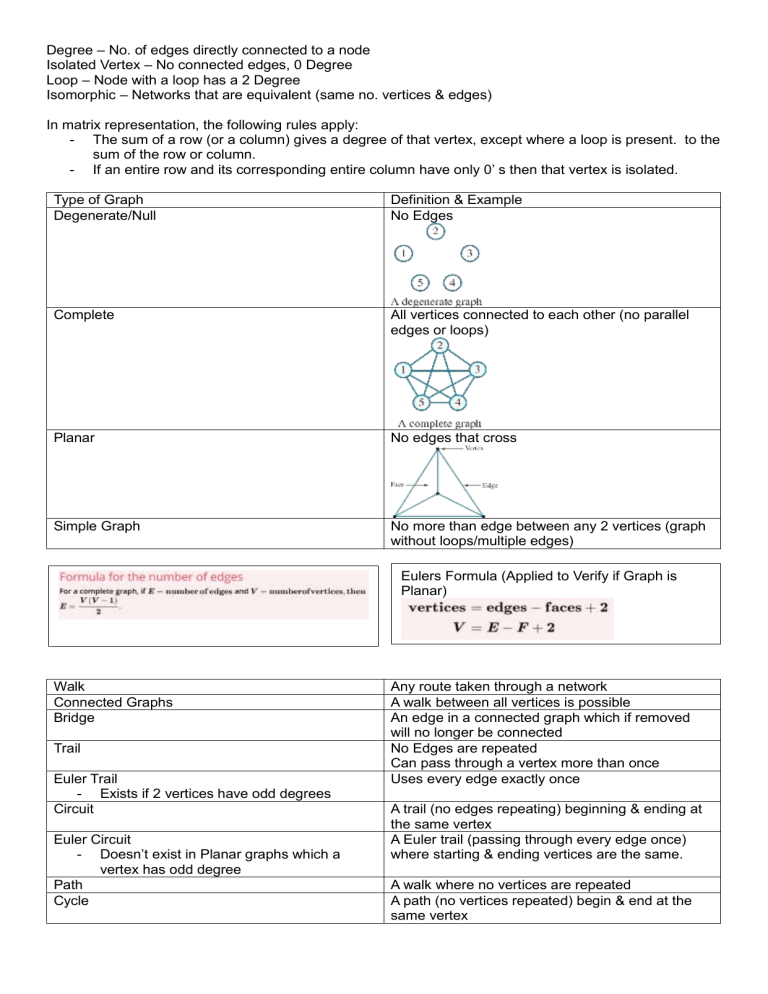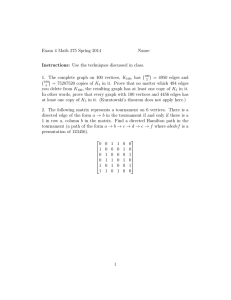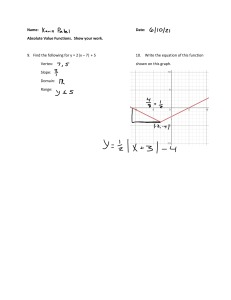
Degree – No. of edges directly connected to a node Isolated Vertex – No connected edges, 0 Degree Loop – Node with a loop has a 2 Degree Isomorphic – Networks that are equivalent (same no. vertices & edges) In matrix representation, the following rules apply: - The sum of a row (or a column) gives a degree of that vertex, except where a loop is present. to the sum of the row or column. - If an entire row and its corresponding entire column have only 0’ s then that vertex is isolated. Type of Graph Degenerate/Null Definition & Example No Edges Complete All vertices connected to each other (no parallel edges or loops) Planar No edges that cross Simple Graph No more than edge between any 2 vertices (graph without loops/multiple edges) Eulers Formula (Applied to Verify if Graph is Planar) Walk Connected Graphs Bridge Trail Euler Trail - Exists if 2 vertices have odd degrees Circuit Euler Circuit - Doesn’t exist in Planar graphs which a vertex has odd degree Path Cycle Any route taken through a network A walk between all vertices is possible An edge in a connected graph which if removed will no longer be connected No Edges are repeated Can pass through a vertex more than once Uses every edge exactly once A trail (no edges repeating) beginning & ending at the same vertex A Euler trail (passing through every edge once) where starting & ending vertices are the same. A walk where no vertices are repeated A path (no vertices repeated) begin & end at the same vertex Hamiltonian Path Hamiltonian Cycle Every vertex used exactly once (not all edges need to be used) A Hamiltonian Path (every vertex used once) starting & finishing at the same vertex Trees can’t contain: - Loops - Parallel/Multiple Edges - Cycles Spanning Tree - A tree that’s a subgraph that includes all the vertices of the original path Minimum Spanning Tree - Covers the shortest distance for a network (consider smallest weighted edges) Maximum Spanning Tree: - Covers the greatest distance for a network (consider largest weighted edges) Dijkstra’s Algorithm: - Method Determining shortest path between vertices EST (Earliest Starting Time): - Earliest time an activity can be started after all prior activities have been completed - Written in the Triangle Forward Scanning: - Calculating EST for each activity & earliest completion time for entire project E.g. Critical Path: - The path through the network which cannot be delayed Float Time: - Difference in time between paths that cannot be delayed by those which can LST (Latest Start Time): - The latest time an activity can begin (be delayed until) E.g. Backward Scanning: - Used to calculate the critical path in a network - Begin at the last node and move backwards subtracting each edge from EST Critical Path Analysis Rules: - 2 vertices can be connected by a max. of 1 edge - An activity must be represented by exactly 1 edge Dummy Activity: - An edge that must be added to a avoid with 2+ activities have the same name or occurring in parallel - Rule 1: 2 vertices can be connected directly by 1 max edge - Rule 2: An activity must be represented by 1 edge only Crashing: - Method to speed up completion time of project by shortening critical path Source – Network Starting Node, Sink – Network ending Node Flow Capacity – the amount of flow an edge can allow through Inflow: - total of flow into the network Outflow – minimum value obtained when comparing inflow to sum of capacities of all edges leaving vertex Excess Flow Capacity – surplus of capacity of an edge – flow into the edge The minimum cut is the cut with the minimum value The maximum flow through a network is equal to the value of the minimum cut. Bipartite Graph – Nodes can be separate into 2 types; supply & demand Optimal Allocation – Most Efficient Result Hungarian Algorithm: Activity Earliest Start Time Duration (Days) A B C D E F G H I J K L 0 0 0 6 5 4 4 13 9 6 5 4 7 4 5 6 2 5 Immediate Predecessor A B C C D E





